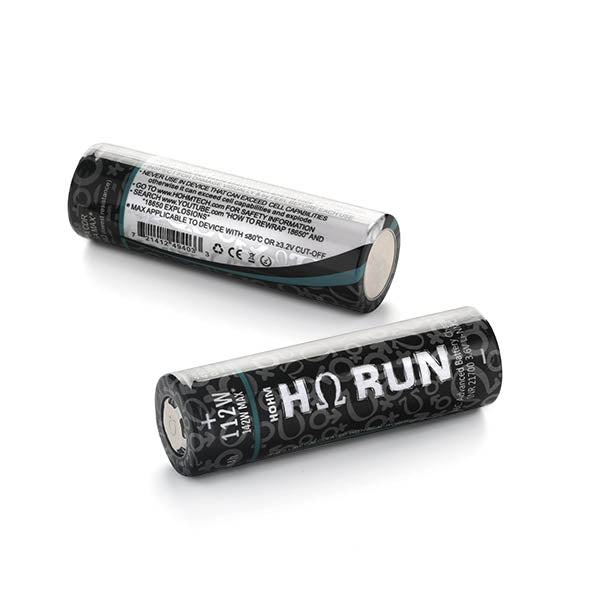Hohm Run 21700 Battery-Single
Hohm Run 21700 Battery-Single
Couldn't load pickup availability

Max Charge Rate: 5.29A
Continuous Discharge Rate: 39.1A
Max @ 80oC | 2.8V cut-off: 49.5A
Cycle Life Retention: 500 Cycles (73%), 1000 (64%)
Chemistry Type: QSP Li-NMC
Extraordinary choice for those that want serious punch in the 21700 world, without forfeiting capacity. With it’s QSP Li-NMC formula, these are officially rated at 3023mAh, with a CDR of 39.1A, and 80oC | 3.2V cut-off limit (whichever occurs first) @ 49.5A. All ratings are subject to meet and/or exceed strict limitation policies set forth for DLr1, TID2, PVDL3, CLR4, mΩR5, and Temperature (°C). Hohm RUN is based off the QSP formulation, with chemistry unity process now at a slower mHz (megahertz) to keep costs down while achieving unprecedented capabilities.
Every Hohm Tech cell model has been tested and certified by UN38.3, EN62133, IEC62133 2nd Edition, and UL1642 accredited laboratories and testing facilities assigned by regulatory bodies. This includes MSDS, CE, ROHS, UN38.3, IEC, Specifications, and Air/Sea Transport certifications. We do not cut corners. We deliver what we promise… chart topping performance, capacity, consistency, and safety.
To expound on safety:
• modified cathode tag consisting of higher purity aluminum is utilized to aid in lowering internal resistance
• updated poly seal with refined bitumen is installed in every cell to ensure excess pressure is controlled
• each cell is fitted with our proprietary EPTC (Enhanced Positive Thermal Coefficient) ring with higher multiplier of resistance
• every cell is equipped with 2-stage CID (Current Interrupt Device) system to aid in overcharge prevention
* NOTICE: Hohm Tech does not manufacture batteries. These are licensed and made specific to the strict requirements set forth.
** CAN BE CHARGED AT 5.29A. This is not a misprint. 5.29A as in FIVE POINT TWO NINE amp charging is possible, tested, proven, and approved within all strict safety protocols set by Indonesia Chemistry.
*** TESTING BEYOND TEMPERATURE. Hohm Tech cells utilize both static & dynamic testing that includes but not limited to: density loss, thermal distribution, volt drop limiters, cycle life retention, and temperature. These tests are imperative to achieve true cell performance, longevity, and overall quality.
1 Density Loss Ratio
2 Thermal Image Distribution
3 Pulse Voltage Drop Limitation
4 Cycle Life Retention
5 Resistance Retentivity Pre|Post


WARNING: LI-ION CELLS HAVE INHERENT RISKS IF MISUSED OR MISHANDLED. IF MISUSED OR MISHANDLED, CELL CAN EXPLODE CAUSING SEVERE BURN INJURY AND PROPERTY DAMAGE. – READ BELOW THOROUGHLY –
CELL = BATTERY
- KEEP OUT OF REACH of anyone under 18 years of age, AND pets.
- DO NOT PUT IN FIRE, oven, microwave, or expose to anything over 100oC (212oF)
- DO NOT CARRY or store OUTSIDE of its protective packaging or a PROTECTIVE CELL CASE.
- DO NOT PUT IN POCKET, bag, purse, or anywhere WITH METAL OBJECTS including COINS and KEYS. Otherwise, cell(s) could short-circuit and explode.
- DO NOT PUT A DEVICE WITH CELL(S) INSTALLED IN POCKET or ON YOUR BODY. As unlikely as it may be, a device can malfunction, have a defect, internal damage, and/or be affected by conductive debris or object(s) in pocket that can overload or short-circuit cell causing it to explode.
- DO NOT USE IN A DEVICE THAT CAN EXCEED MAX CELL WATTAGE (W) or AMPERAGE (A) (listed on each cell and retail packaging). Otherwise, this can overload a cell, causing it to explode.
- DO NOT USE A LOWER RESISTANCE (Ω) # (listed on each cell and retail packaging). Otherwise, this can overload cell, causing it to explode.
- DO NOT USE CELL WITH ANY DAMAGE TO ITS STRUCTURE OR OUTER PROTECTIVE LABEL (also called “WRAP”, “sleeve”, “skin”). Damage may include: dent(s), tear(s), nick(s), puncture(s), corrosion, or any other undisclosed abnormalities or damages. Otherwise, a cell can short-circuit and explode. ALWAYS INSPECT cell VISUALLY and by TOUCH to SEE/FEEL for damage BEFORE EACH USE. ** SEE ILLUSTRATION BELOW AS GUIDELINE. **
- DO NOT LEAVE UNATTENDED WHILE CHARGING, & REMOVE CELL(s) FROM CHARGER ONCE FULLY CHARGED to ensure it is not exposed to any potential charger malfunction such as overcharging which could damage cell causing it to explode.
- DO NOT CHARGE HIGHER THAN MAX CHARGE VOLTAGE (V) (typically 4.2V) or DISCHARGE BELOW MAX VOLTAGE CUT-OFF (V) (typically 2.5V). Overcharging or over-discharging cell(s) can cause irreversible damage and cause it to explode.
- DO NOT MIX WITH USED or DIFFERENT BATTERY TYPES. Differences in cell capacity can lead to one or more cell(s) being overcharged or over-discharged.
- IF USING A MULTI-CELL DEVICE, IT MUST HAVE A NON-CONDUCTIVE BARRIER (typically plastic) to PREVENT CELL(S) FROM TOUCHING THE SIDE(S) OF ANY OTHER CELL AND ANY ADJACENT METAL except for the very center of top and bottom of the cell. Otherwise, cell(s) could short-circuit and explode.
- ALWAYS use, connect, charge, and operate cell(s) within their capabilities as listed on each cell, packaging, and product detail pages, while adhering to the device’s user manual.
- COMPLETELY READ and follow the WARNING section listed on each cell, packaging, and here, in its entirety.
- SEARCH www.YouTube.com for “18650 EXPLOSIONS” to understand the importance of consistently taking safety precautions and using Li-ion cells properly. Hohm Tech advocates recycling and replacing any damaged Li-ion cell/battery. As a tool to find your LOCAL RECYCLE CENTER. Or visit Hohm Tech Warranty Center for recycling and replacement. Your safety is #1.
Vape Stack will not be held responsible or liable for any injury, damage, or defect, permanent or temporary that may be caused by the improper use of a Li-ion (Lithium-ion), LiPo (Lithium-ion Polymer) and any rechargeable battery/batteries. Please have a basic understanding of the batteries you are using and how to care for them properly.

Share





